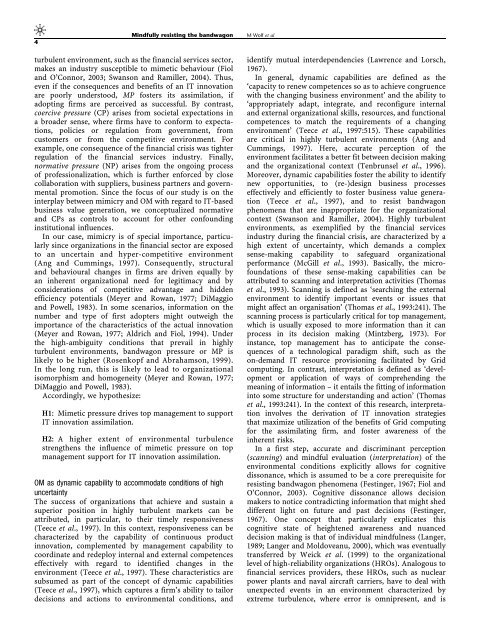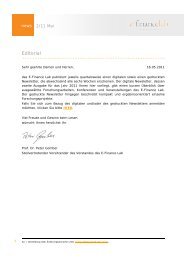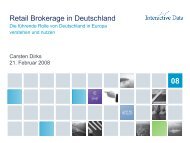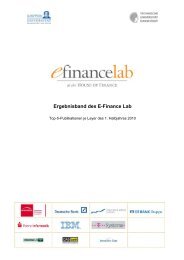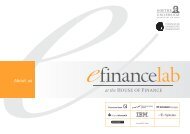Prof. Dr. Wolfgang König, Prof. Dr.-Ing. Ralf ... - E-Finance Lab
Prof. Dr. Wolfgang König, Prof. Dr.-Ing. Ralf ... - E-Finance Lab
Prof. Dr. Wolfgang König, Prof. Dr.-Ing. Ralf ... - E-Finance Lab
Create successful ePaper yourself
Turn your PDF publications into a flip-book with our unique Google optimized e-Paper software.
4<br />
Mindfully resisting the bandwagon M Wolf et al<br />
turbulent environment, such as the financial services sector,<br />
makes an industry susceptible to mimetic behaviour (Fiol<br />
and O’Connor, 2003; Swanson and Ramiller, 2004). Thus,<br />
even if the consequences and benefits of an IT innovation<br />
are poorly understood, MP fosters its assimilation, if<br />
adopting firms are perceived as successful. By contrast,<br />
coercive pressure (CP) arises from societal expectations in<br />
a broader sense, where firms have to conform to expectations,<br />
policies or regulation from government, from<br />
customers or from the competitive environment. For<br />
example, one consequence of the financial crisis was tighter<br />
regulation of the financial services industry. Finally,<br />
normative pressure (NP) arises from the ongoing process<br />
of professionalization, which is further enforced by close<br />
collaboration with suppliers, business partners and governmental<br />
promotion. Since the focus of our study is on the<br />
interplay between mimicry and OM with regard to IT-based<br />
business value generation, we conceptualized normative<br />
and CPs as controls to account for other confounding<br />
institutional influences.<br />
In our case, mimicry is of special importance, particularly<br />
since organizations in the financial sector are exposed<br />
to an uncertain and hyper-competitive environment<br />
(Ang and Cummings, 1997). Consequently, structural<br />
and behavioural changes in firms are driven equally by<br />
an inherent organizational need for legitimacy and by<br />
considerations of competitive advantage and hidden<br />
efficiency potentials (Meyer and Rowan, 1977; DiMaggio<br />
and Powell, 1983). In some scenarios, information on the<br />
number and type of first adopters might outweigh the<br />
importance of the characteristics of the actual innovation<br />
(Meyer and Rowan, 1977; Aldrich and Fiol, 1994). Under<br />
the high-ambiguity conditions that prevail in highly<br />
turbulent environments, bandwagon pressure or MP is<br />
likely to be higher (Rosenkopf and Abrahamson, 1999).<br />
In the long run, this is likely to lead to organizational<br />
isomorphism and homogeneity (Meyer and Rowan, 1977;<br />
DiMaggio and Powell, 1983).<br />
Accordingly, we hypothesize:<br />
H1: Mimetic pressure drives top management to support<br />
IT innovation assimilation.<br />
H2: A higher extent of environmental turbulence<br />
strengthens the influence of mimetic pressure on top<br />
management support for IT innovation assimilation.<br />
OM as dynamic capability to accommodate conditions of high<br />
uncertainty<br />
The success of organizations that achieve and sustain a<br />
superior position in highly turbulent markets can be<br />
attributed, in particular, to their timely responsiveness<br />
(Teece et al., 1997). In this context, responsiveness can be<br />
characterized by the capability of continuous product<br />
innovation, complemented by management capability to<br />
coordinate and redeploy internal and external competences<br />
effectively with regard to identified changes in the<br />
environment (Teece et al., 1997). These characteristics are<br />
subsumed as part of the concept of dynamic capabilities<br />
(Teece et al., 1997), which captures a firm’s ability to tailor<br />
decisions and actions to environmental conditions, and<br />
identify mutual interdependencies (Lawrence and Lorsch,<br />
1967).<br />
In general, dynamic capabilities are defined as the<br />
‘capacity to renew competences so as to achieve congruence<br />
with the changing business environment’ and the ability to<br />
‘appropriately adapt, integrate, and reconfigure internal<br />
and external organizational skills, resources, and functional<br />
competences to match the requirements of a changing<br />
environment’ (Teece et al., 1997:515). These capabilities<br />
are critical in highly turbulent environments (Ang and<br />
Cummings, 1997). Here, accurate perception of the<br />
environment facilitates a better fit between decision making<br />
and the organizational context (Tenbrunsel et al., 1996).<br />
Moreover, dynamic capabilities foster the ability to identify<br />
new opportunities, to (re-)design business processes<br />
effectively and efficiently to foster business value generation<br />
(Teece et al., 1997), and to resist bandwagon<br />
phenomena that are inappropriate for the organizational<br />
context (Swanson and Ramiller, 2004). Highly turbulent<br />
environments, as exemplified by the financial services<br />
industry during the financial crisis, are characterized by a<br />
high extent of uncertainty, which demands a complex<br />
sense-making capability to safeguard organizational<br />
performance (McGill et al., 1993). Basically, the microfoundations<br />
of these sense-making capabilities can be<br />
attributed to scanning and interpretation activities (Thomas<br />
et al., 1993). Scanning is defined as ‘searching the external<br />
environment to identify important events or issues that<br />
might affect an organisation’ (Thomas et al., 1993:241). The<br />
scanning process is particularly critical for top management,<br />
which is usually exposed to more information than it can<br />
process in its decision making (Mintzberg, 1973). For<br />
instance, top management has to anticipate the consequences<br />
of a technological paradigm shift, such as the<br />
on-demand IT resource provisioning facilitated by Grid<br />
computing. In contrast, interpretation is defined as ‘development<br />
or application of ways of comprehending the<br />
meaning of information – it entails the fitting of information<br />
into some structure for understanding and action’ (Thomas<br />
et al., 1993:241). In the context of this research, interpretation<br />
involves the derivation of IT innovation strategies<br />
that maximize utilization of the benefits of Grid computing<br />
for the assimilating firm, and foster awareness of the<br />
inherent risks.<br />
In a first step, accurate and discriminant perception<br />
(scanning) and mindful evaluation (interpretation) of the<br />
environmental conditions explicitly allows for cognitive<br />
dissonance, which is assumed to be a core prerequisite for<br />
resisting bandwagon phenomena (Festinger, 1967; Fiol and<br />
O’Connor, 2003). Cognitive dissonance allows decision<br />
makers to notice contradicting information that might shed<br />
different light on future and past decisions (Festinger,<br />
1967). One concept that particularly explicates this<br />
cognitive state of heightened awareness and nuanced<br />
decision making is that of individual mindfulness (Langer,<br />
1989; Langer and Moldoveanu, 2000), which was eventually<br />
transferred by Weick et al. (1999) to the organizational<br />
level of high-reliability organizations (HROs). Analogous to<br />
financial services providers, these HROs, such as nuclear<br />
power plants and naval aircraft carriers, have to deal with<br />
unexpected events in an environment characterized by<br />
extreme turbulence, where error is omnipresent, and is


